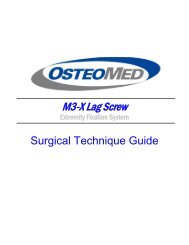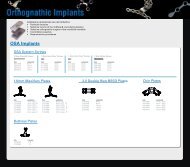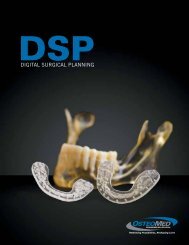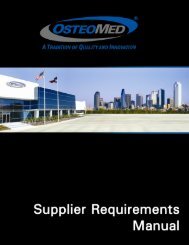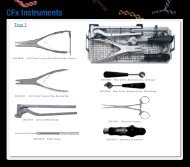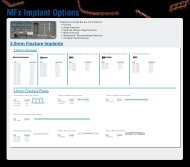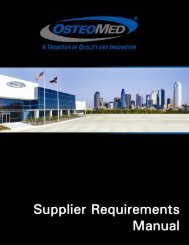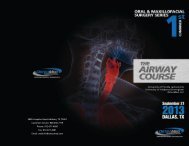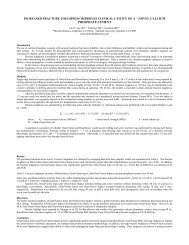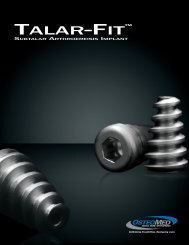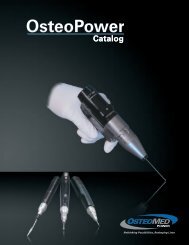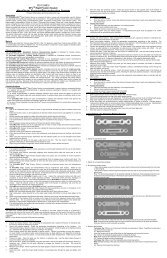STG - OsteoMed
STG - OsteoMed
STG - OsteoMed
You also want an ePaper? Increase the reach of your titles
YUMPU automatically turns print PDFs into web optimized ePapers that Google loves.
LOGIC<br />
TM<br />
Mandibular Distraction System<br />
SURGICAL TECHNIQUE GUIDE<br />
In d i c at i o n s<br />
The OSTEOMED LOGIC Mandibular Distractor system is indicated<br />
for use as a mandibular bone lengthener for patients diagnosed with<br />
conditions where treatment includes mandibular distraction osteogenesis.<br />
These conditions may include diagnoses such as mandibular<br />
micrognathia or hemi facial microsomia. The device is designed to<br />
provide distraction along a curvilinear or straight path approximating<br />
the natural growth of the mandible.<br />
General Cau t i o n s<br />
Read all information in this manual before implanting the device. Before<br />
clinical use, the surgeon should be familiar with all aspects of the<br />
OSTEOMED LOGIC Mandibular Distractor, its instrumentation, indications<br />
and contraindications. Accepted surgical practice should be followed in<br />
postoperative care.<br />
• The patient/guardian is to be warned that the device can break or<br />
loosen as a result of stress, excessive activity or inappropriate diet.<br />
• The patient/guardian is to be made aware of the surgical<br />
risks and possible adverse effects prior to surgery, and<br />
warned that failure to follow postoperative care<br />
instructions can cause failure of the implant and the<br />
treatment.<br />
• Surgeon should limit patient activity while device is<br />
implanted.<br />
• Surgeon should limit patient to a soft diet for the duration of the distraction<br />
period.<br />
• Precautions should be taken to avoid damage to the<br />
inferior alveolar nerve and tooth buds.<br />
Co n t r a i n d i c at i o n s<br />
Use of the OSTEOMED LOGIC Mandibular Distractor system is<br />
contraindicated in cases of active or suspected infection, in patients<br />
previously sensitized to nickel, titanium or silicone, in patients with<br />
certain metabolic diseases, or in patients who are immune compromised.<br />
It is further contraindicated in patients exhibiting disorders<br />
which would cause the patient to ignore the limitations of distraction<br />
osteogenesis. The <strong>OsteoMed</strong> LOGIC mandibular distractor system is<br />
also contraindicated in those cases where there is inadequate volume<br />
or quantity of bone to place the distractor securely.<br />
WARNING indicates a potentially hazardous situation which,<br />
if not avoided, could result in death or serious injury and may<br />
result in property damage.<br />
CAUTION used without the safety alert symbol indicates a potentially<br />
hazardous situation which, if not avoided, may result<br />
in property damage.<br />
Lat e n c y Pe r i o d<br />
The latency period is the time period between the initial surgery<br />
when the distraction device is placed and when the distraction<br />
begins. The duration of the latency period is to be determined<br />
by the surgeon.<br />
Distraction Pe r i o d<br />
The distraction period is the time period during which the distraction<br />
is taking place. The duration of the distraction period is to be determined<br />
by the surgeon.<br />
Co n s o l i dat i o n Pe r i o d<br />
The consolidation period is the period of time that commences when<br />
distraction has ceased. The device remains fixated for the consolidation<br />
period to allow for the healing and solidification of the newly<br />
formed bone. The duration of the consolidation period is to be determined<br />
by the surgeon.<br />
General Wa r n i n g s<br />
This device is intended for single patient use only and should be removed once<br />
the prescribed distraction has been achieved and the consolidation period has<br />
been concluded. (Note: Consolidation Period is determined by the surgeon).<br />
Plates, screws, wires, or other appliances of dissimilar metals should not be<br />
used together in or near the implant site.<br />
• Plates, screws, wires, or other appliances of dissimilar metals should not<br />
be used together in or near the implant site.<br />
• Multiple bending may weaken the device and could result in implant<br />
fracture and failure.<br />
• Do not remove activation wire before the consolidation period has been<br />
completed.<br />
• Distractor must be fixated with a minimum of 2 screws on each side of<br />
the osteotomy and the screws should be placed in multiple plate arms.<br />
• The activation wire must be turned in the direction of the arrow as<br />
indicated on the handle of the distraction tool.<br />
• Patient’s activities must be governed according to the limitations of the<br />
device.<br />
• Surgeon should limit patient to a soft diet for the duration of the<br />
distraction period.<br />
• Precautions should be taken to avoid damage to the inferior alveolar<br />
nerve.<br />
• During distraction and consolidation period, the soft-tissue portal must<br />
remain clean.<br />
• Minimal MRI scattering is possible due to nickel present in the activation<br />
wire.<br />
• The silicone tubing is indicated for a maximum implant period of 29<br />
days.<br />
• Excessive torque on the activation wire may cause the wire to break.<br />
• Failure to follow Planning instructions may contribute to patient harm.<br />
• Failure to follow Implantation instructions may cause patient harm or<br />
device damage.<br />
• Failure to follow Distraction instructions may cause patient harm or<br />
device damage.<br />
• Failure to follow Distractor removal instructions may cause patient<br />
harm.<br />
• The devices can break or be damaged due to excessive activity or<br />
trauma. This could lead to failure of the distractor and/or screws which<br />
could require additional surgery and device removal.<br />
• It is recommended to remove any fractured implants from patients during<br />
surgery. If unable to remove, notify patient/guardian.<br />
• Use of screws in high dense bone may lead to implant fracture or failure<br />
upon insertion.<br />
1
TM<br />
LOGIC<br />
Mandibular Distraction System<br />
Sy s t e m Co m p o n e n t s<br />
Di s t r ac t o r s<br />
Distraction To o l<br />
P/N 216-0102<br />
Three rotations = 1mm distraction. The patient or patient guardian should be<br />
thoroughly instructed on use of the distraction tool and receive a copy of the<br />
“Patient Progress Chart.”<br />
Ot h e r To o l s<br />
Taperlock Screwdriver body<br />
P/N 220-0019<br />
Plate Bending Forceps<br />
P/N 220-0049<br />
Ac t i vat i o n Wi r e s<br />
92mm P/N 216-0308<br />
82mm P/N 216-0307<br />
72mm P/N 216-0306<br />
62mm P/N 216-0302<br />
52mm P/N 216-0301<br />
42mm P/N 216-0300<br />
Cheek Retractor, Blade, M4/<br />
Dist<br />
P/N 220-0564<br />
Plate Cutter<br />
P/N 220-0028<br />
Cannula Trocar<br />
P/N 220-0056<br />
Silicone Tu b i n g<br />
(indicated to remain in the body a<br />
maximum of 29 days)<br />
P/N 216-0305<br />
Cannula Drill Guide<br />
P/N 220-0140<br />
Small Grasping Forceps<br />
P/N 220-0027<br />
Cannula<br />
P/N 220-0055<br />
Activation Wire Removal Tool<br />
P/N 216-0103<br />
2
TM<br />
LOGIC<br />
Mandibular Distraction System<br />
In s t r u c t io n s f o r Us e<br />
P/N<br />
204-1202<br />
204-1203<br />
204-1204<br />
204-1206<br />
204-1208<br />
211-1203<br />
211-1204<br />
211-1205<br />
Sc r e w s<br />
Description<br />
1.2mm x 2mm Screw<br />
1.2mm x 3mm Screw<br />
1.2mm x 4mm Screw<br />
1.2mm x 6mm Screw<br />
1.2mm x 8mm Screw<br />
1.2mm x 3mm Auto-Drive Screw<br />
1.2mm x 4mm Auto-Drive Screw<br />
1.2mm x 5mm Auto-Drive Screw<br />
Use of the Template:<br />
1. Place tracing paper over lateral headfilm and trace all hard<br />
and soft tissue landmarks.<br />
2. Use the template to trace teeth onto tracing paper.<br />
3. Determine location of the mental foramen, the inferior<br />
alveolar foramen, the pterygoid raphe and therefore the foramen<br />
ovale.<br />
4. Once landmarks are established a Surgical Treatment Objective<br />
should be made:<br />
Su r g i c a l Pr e-Pl a n n i n g<br />
Placement Planning and Choosing the Curve:<br />
The patient or patient’s guardian should receive the “Patient’s<br />
Progress Chart” to insure proper instruction and tracking of<br />
distraction.<br />
The <strong>OsteoMed</strong> Logic TM Mandibular Distractor System offers<br />
three different curved designs and one straight design which<br />
approximate natural jaw growth. The curve is chosen based on<br />
the desired mandibular movement in the horizontal and vertical<br />
directions. It should be based on the projection tracing<br />
using a lateral cephalometric radiograph. The lateral headfilm<br />
is used for planning, the frontal headfilm is used for determining<br />
asymmetry, and the panorex is used to determine position<br />
of the teeth.<br />
During pre-op planning, the template (P/N 216-0310) should<br />
be used with x-rays taken of the distraction site in order to select<br />
the appropriate distractor curve and plan the necessary<br />
distraction. The planning template features two logarithmic<br />
spirals, the Moss Spiral and the Golden Spiral. The Moss Spiral<br />
will be used for the majority of patients and the Golden Spiral<br />
is indicated for use with brachiocephalic patients where the<br />
jaw tends to be more square.<br />
When selecting the appropriate curve, it is important to consider<br />
the following:<br />
1. Amount of mandibular bone present<br />
2. Location of osteotomy<br />
3. Amount and direction of distraction<br />
• Correct length of activaiton wire based on planned<br />
distraction and length between fixation point and<br />
access point.<br />
• Surgical Treatment Objective (STO) determines the desired<br />
final position of teeth and chin. Check to insure that the<br />
soft tissue chin is close to the ideal relationship. A drawing<br />
of the ideal relationship can be found on the template.<br />
• Using the landmarks in conjunction with either the Moss<br />
Spiral or the Golden Spiral determines which distractor<br />
should be used. The foramen ovale, inferior alveolar foramen<br />
and mental foramen positions determined by STO<br />
should fall on this curve.<br />
5. Position the chosen spiral over the foramen ovale, inferior<br />
alveolar foramen and the mental foramen as determined by<br />
the STO. Trace the logarithmic curve onto the tracing paper in<br />
this position.<br />
6. Place drawings of devices on top of the curve and determine<br />
which curve best fits the spiral, taking into consideration the<br />
position of the osteotomy. The cut placement should be based<br />
on the nerve location, location of tooth buds, bone stock, and<br />
access. Special attention should be given to the rotational orientation<br />
of the distractor. Positioning the distractor more vertical<br />
or horizontal favors that direction and should be based on<br />
the x-rays.<br />
7. Trace curve of the appropriate distractor, screw hole positions<br />
and the osteotomy onto the tracing<br />
`<br />
1. 2. 3.<br />
3
TM<br />
LOGIC<br />
Mandibular Distraction System<br />
In s t r u c t io n s f o r Us e<br />
1.<br />
2.<br />
3.<br />
Pr e pa r at i o n o f Distraction Site<br />
Make an intraoral incision from mid-ramus height to lateral to the second mandibular molar.<br />
Perform a subperiosteal dissection to expose the lateral ramus.<br />
Position of the cut should be determined based on desired mandibular movement. It should be made more horizontal for vertical<br />
distraction and more vertical for horizontal distraction. Using the saw, score the lateral mandible, then cut through both<br />
buccal and lingual cortices at the posterior or inferior border and at the anterior border. Make certain the osteotomy is made<br />
above or in front of the inferior alveolar nerve.<br />
More horizontal osteotomy for<br />
vertical distraction<br />
Osteotomy at the angle of the mandible<br />
for distraction in both horizontal<br />
and vertical vectors<br />
More vertical osteotomy for horizontal<br />
distraction<br />
Repeated bending of the device by the surgeon may cause the device to weaken or fracture.<br />
Placement o f Distractor<br />
1.<br />
2.<br />
3.<br />
Before engaging the activation wire place the silicone tubing over the wire.<br />
Check device to ensure free articulation between the two moving plates. They should slide freely.<br />
Using bending pliers, adjust the fixation plates of the distractor to accommodate the natural curve of the mandible.<br />
4.<br />
Determine if the activation wire will exit through the cheek or if it will remain intraoral. If the activation wire will exit through the<br />
cheek, an incision in the cheek must be made. Engage the activation wire into the distractor before fixating.<br />
The silicone tubing is indicated for a maximum implant period of 29 days.<br />
4
TM<br />
LOGIC<br />
Mandibular Distraction System<br />
In s t r u c t io n s f o r Us e<br />
7. When fixating the stationary base plate of the distractor,<br />
place one screw in each arm. Then place remaining screws<br />
in additional holes.<br />
5. Ensure that the activation wire has engaged both parts of<br />
the distractor and is working by advancing wire NO more than<br />
2-3mm. Advancing the distractor too far will result in excessive<br />
torque and possible damage when attempting to return the distractor<br />
to the starting position.<br />
6. Fixate the distractor to the mandible using 1.6mm screws or<br />
2.0mm screws.<br />
Distractor must be fixated with a minimum<br />
of 2 screws on each side of the<br />
osteotomy.<br />
8. Fixate the moving plate of the distractor placing the screws<br />
5mm away from the osteotomy. Screws should be placed in<br />
multiple mesh arms.<br />
There are two areas of the distractor that must be fixated to<br />
the mandible:<br />
1) The stationary base plate<br />
2) The moving plate<br />
Bi-cortical fixation of the distractor is not always necessary.<br />
Cl o s u r e o f t h e Distraction Site<br />
1. After the distractor has been securely fixated, complete the<br />
osteotomy using an osteotome, taking care to avoid<br />
damaging the inferior alveolar nerve.<br />
2. Suture the intraoral wound closed. Meticulous hemostasis<br />
and wound closure are necessary to minimize hematoma<br />
and infection. If the activation wire exits through the skin,<br />
wound care should routinely be done.<br />
Screws may be placed using either a trans-buccal approach<br />
or by using a contra angle drill and screwdriver.<br />
5
TM<br />
LOGIC<br />
Mandibular Distraction System<br />
In s t r u c t io n s f o r Us e<br />
Da i ly Distraction<br />
Distraction is recommended to begin at the conclusion of the<br />
latency period and continue at a rate as determined by the<br />
surgeon until the desired distraction is achieved.<br />
2. Slide the distraction tool (P/N 216-0102) over the hex nut<br />
of the activation wire as shown below. In one swift motion<br />
snap the hex nut by applying force.<br />
The distraction tool is used by the patient or patient guardian<br />
to rotate the activation wire and initiate distraction.<br />
Three turns of the distraction tool will approximate 1mm of<br />
distraction.<br />
3. Remove the silicone tubing and discard in accordance<br />
with standard bio-hazardous waste disposal procedures.<br />
Slide the activation wire removal tool (P/N 216-0103)<br />
over the activation wire until it is flush with the moving<br />
plate as shown below.<br />
The patient or patient guardian should make sure<br />
that the turns are made in the direction of the<br />
arrow indicated on the flat of the distraction tool.<br />
4. Using a quick lateral force, snap the activation wire where<br />
it enters the moving plate as shown below. Discard the<br />
activation wire and distraction tool in accordance with<br />
standard bio-hazard waste disposal procedures. The<br />
remainder of the activation wire will remain, supporting<br />
the distractor in the expanded position.<br />
Po s t Distraction Pe r i o d<br />
After the desired distraction has been achieved, the portion<br />
of the activation wire protruding through the mucosa may be<br />
snapped off and discarded, along with the silicone tubing, according<br />
to standard biohazard disposal procedures. The end<br />
of the activation wire will then retract beneath the skin and<br />
remain there for the duration of the consolidation period. The<br />
distractor should remain implanted for the consolidation period<br />
determined by the surgeon.<br />
Distractor Re m o v a l<br />
1.<br />
Ac t i vat i o n Wi r e Re m o v a l<br />
Hold the activation wire with grasping forceps near the hex<br />
nut as shown below.<br />
It is recommended that the distractor remain<br />
implanted for the consolidation period after<br />
desired distraction has been achieved as determined by the<br />
surgeon.<br />
1.<br />
2.<br />
3.<br />
4.<br />
Make the intraoral incision from mid-ramus height to lateral<br />
to the second mandibular molar and expose the distractor.<br />
Remove the screws fixating the distractor to the mandible.<br />
Remove the distractor and discard according to standard<br />
biohazard disposal procedures.<br />
Suture the distraction site closed.<br />
6
TM<br />
LOGIC<br />
Mandibular Distraction System<br />
Pr o g r e s s Ch a r t<br />
MANDIBULAR DISTRACTOR PATIENT/GUARDIAN INSTRUCTIONS FOR USE<br />
AND PATIENT PROGRESS CHART<br />
Patient Name:<br />
Physician Name:<br />
First Distraction Date:<br />
Last Distraction Date:<br />
Physician Phone:<br />
Distraction Plan<br />
Turns AM:<br />
Turns Noon:<br />
Turns PM:<br />
The patient/guardian should track the patient progress from the beginning of distraction to the end as instructed by the<br />
physician.<br />
A copy of this progress report should be given to the physician once the distraction has been completed.<br />
If you have any questions or concerns, please contact your physician.<br />
Day Date<br />
Rotations Day Date<br />
Rotations<br />
AM Noon<br />
PM<br />
AM Noon<br />
PM<br />
1<br />
2<br />
3<br />
4<br />
5<br />
6<br />
7<br />
8<br />
9<br />
10<br />
11<br />
12<br />
13<br />
14<br />
15<br />
16<br />
17<br />
18<br />
19<br />
20<br />
21<br />
22<br />
23<br />
24<br />
25<br />
26<br />
27<br />
28<br />
29<br />
30<br />
31<br />
32<br />
33<br />
34<br />
35<br />
36<br />
37<br />
38<br />
39<br />
40<br />
7
TM<br />
LOGIC<br />
Mandibular Distraction System<br />
Daily Instructions<br />
1. Engage the hex nut of the activation wire with the internal hex of the distraction tool.<br />
2. Rotate the distraction tool in the direction of the arrow on the distraction tool. Three (3) rotations advances the distractor<br />
1mm.<br />
Patient or patient guardian should rotate the activation wire<br />
______ full rotation(s)<br />
______ time(s) per day<br />
Precautions to the patient’s guardian:<br />
Your doctor has fitted you with a distraction device to aid in the lengthening of your mandible. This process requires you to be<br />
familiar with the instructions for daily use of this distractor. Patient progress should be tracked on the “Patient Progress Chart”<br />
inside this pamphlet. Your compliance with your physician’s instructions will help ensure positive outcome. If you have any<br />
questions or concerns, contact the physician.<br />
Notes to the physician:<br />
Please be sure the patient or patient guardian has read and understands this pamphlet before implanting the mandibular<br />
distractor.<br />
The patient guardian should track progress on the progress chart.<br />
8



